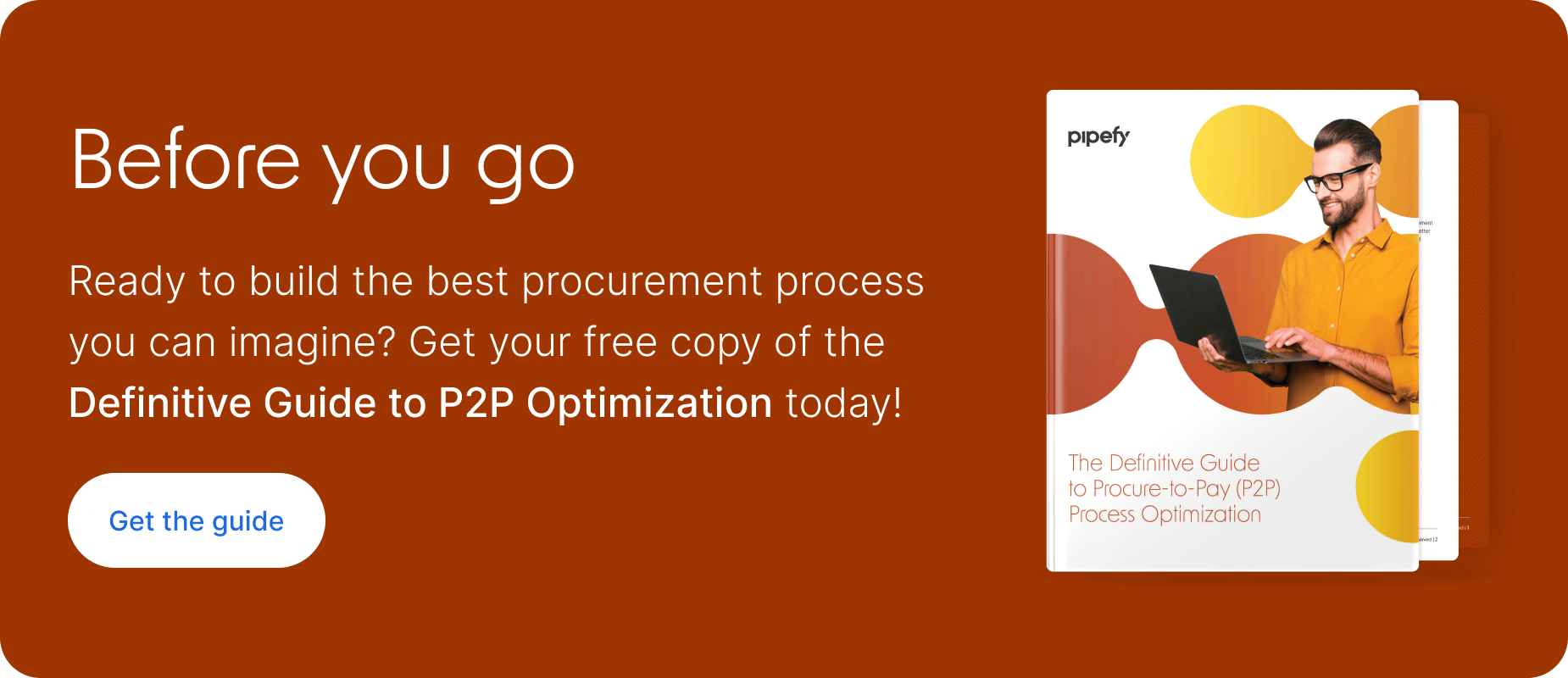
What is a purchasing process?
A purchasing process is made up of all the steps required to fulfill payment for any goods/services that have been requested for purchase. This may vary based on company process structures and needs, but steps in this process typically involve:
- Reviewing and approving purchase requisitions
- Generating and issuing purchase orders
- Negotiating prices, contracts, or payment terms
- Monitoring spending
The purchasing process involves various stakeholders, including procurement, requesters, approvers, vendors/suppliers, and purchasing and accounts payable departments.
Improve your procure-to-pay processes for more savings and oversight with the Definitive Guide to P2P Optimization
Purchasing process example
The purchasing process begins once a purchase request is submitted for review. Once approved, a purchase order is created and issued to be fulfilled by the supplier/vendor that was selected and approved.

Business purchases categories
A business relies on various suppliers and vendors to fulfill purchases to keep its business running and help meet customer needs. Depending on the business and its needs, there are four common types of business purchases:
- Software (like product licenses or business process automation technology)
- Services (like facility management or catering services)
- Goods or products (like office equipment)
- Raw materials that are needed to create a completed product (like fabric or ingredients)
Learn more about the types of business purchases.
Purchasing vs. procurement
Purchasing and procurement are often used interchangeably or synonymously. However, the purchasing process is part of the larger procurement process. To understand how these processes work (and how they’re different), think of a bike chain and the many small links that make up the chain.
If procurement is the overall bike chain, then the purchasing process is one of the links that make up the chain. In order for the chain to loop and for the bike to move forward, these processes work together and inform one another to keep the bike (or business) running in the most cost-effective way possible. In other words, the strategy informs the transactions and the transactions inform the strategy.

Learn more about the difference between procurement vs. purchasing.
Related process
The two other links that makeup procurement are source-to-pay and procure-to-pay. Both of these processes ensure that the best suppliers are sourced at the best price and terms.
For example, because the procurement process involves making payments for goods and services, within this process exists another workflow known as procure-to-pay.
The procure-to-pay process helps integrate the purchasing and accounts payable process to ensure that invoices and payments are managed in a more streamlined, accurate, and efficient way — without delay or internal interruptions due to missed approvals.
Learn more about procure-to-pay and source-to-pay and how teams can leverage P2P automation software to improve purchasing.
Why is the purchase process important?
The purchasing process is important because it provides a structured approach to negotiating and buying the goods or services a business needs to directly or indirectly generate business value.
It not only guarantees compliance, but it also prevents procurement bypass and invisible spending due to unregulated spending.
Key purchasing process cycle steps
1. Understand business needs
While this isn’t exactly a step, it is an essential starting point for managing how a business is spending money, identifying opportunities to maximize cost savings, cutting unnecessary spending, and managing any supply chain disruptions.
For example, if a company needs a large volume of items, like computers, there may be an opportunity for negotiating discounts.
2. Create a purchase requisition
The purchasing process begins when a requester creates and submits a purchase request. You can streamline this process and improve the request process by creating a standardized request form so that purchase requisitions are consistent and compliant with your team’s data management needs.
3. Screen the requests
Screening purchase requests ensures that all company purchases are accurate, within budget, and, more importantly, necessary.
4. Search for suppliers
Once the request has been screened and approved for sourcing, the purchasing team will work on identifying suppliers/vendors that can fulfill the request.
Learn more about strategic sourcing and how this process is essential to sourcing the best suppliers.
5. Request for proposals
Once the best products have been sourced, it’s common for the purchasing team to request proposals to ensure their products or services are within budget, able to be delivered on time, and compliant with your business policies or requirements.
6. Negotiate costs and contract terms
There may be cases where all the boxes are checked except for pricing or payment terms. For example, maybe the quality isn’t ideal, but the supplier is the only one that can meet the demand by a certain date. In this case, the purchasing team will negotiate for a more reasonable purchase total.
7. Approval
If all the many pieces of the process up to this point meet all the requirements — like pricing, delivery, and payment terms — and the purchasing team is satisfied, then the purchase request is ready for final approval. If it’s rejected, then the purchasing team will let the requester know, or they will attempt to find a different supplier or vendor.
Some reasons for rejection include the cost being too much, there wasn’t enough value generated for the business with the purchase, the purchase was not approved by a department manager, or the purchase being duplicative.
8. Issue a purchase order
Once all the approvals are received, the purchasing team will generate a purchase order based on the approved purchase request details and issue it to the selected supplier/vendor for fulfillment.
Ready to get started but don’t have the time or resources to build a custom solution for your purchase process? Learn how to build an error-proof purchasing process with this template tutorial.
Common challenges that affect these steps
No matter the size of a business, process challenges are bound to develop, and not addressing these challenges before they grow bigger can lead to long-term business issues. This is especially true for businesses experiencing rapid growth.
No matter the industry or business size, there’s one quality that can be traced back to most challenges: manually managing the purchasing process. Here are some additional issues that can stem from not digitalizing the purchasing process.
Human errors
We’re humans, not robots. So when processes are managed manually by humans, it’s likely that at some point unintentional mistakes will be made. This is especially true when handling repetitive data entry or management work.
For example, let’s say a purchase request for 10 computers was approved and the person in charge of purchase orders mistakenly submitted a PO requesting 100 computers. While it may seem small, this costly error affects the overall business because there are now 90 extra computers that need to be accounted for, and it ultimately leads to more work for the purchasing and procurement team to correct.
Poor communication that leads to delayed or missing approvals
Imagine that a time-sensitive request needs to be approved within the next five hours in order to be delivered by a certain deadline. The item has been sourced and the supplier has agreed to payment terms and discounts that make the overall purchase a perfect match for your budget.
The problem? The approver failed to make the approval deadline and now the entire purchase is delayed. And at the core of this problem is a breakdown in communication that could be easily automated.
Not only is this delay in approval an annoyance that impacts the purchasing team, but it also impacts the finance team (incurred costs) and the relationship with suppliers or vendors (may be less likely to negotiate contract terms and prices in the future).
Siloed collaboration
In order for the purchasing process to run smoothly, streamlined collaboration is necessary and any silos between teams and departments need to be broken down. This is something that can be hard to do for manually managed processes.
Lack of process visibility
Work decentralization and unstructured processes make it difficult to have full visibility into the purchasing process, therefore impacting costs and internal/external stakeholder collaboration. It also makes it difficult to identify bottlenecks, as well as possible opportunities to improve inefficiencies and identify cost savings.
Simplify your purchasing with low-code automation
Business process automation (BPA) is the perfect solution for cutting out digitally transforming your purchasing process and eliminating the manual tasks (and resulting complications) that limit process efficiency and effective collaboration and communication.
Pipefy’s purchasing software streamlines the flow of information between systems and collaborators by centralizing and automating tasks, creating a better experience for requesters and procurement and finance teams.
With Pipefy, integrate your existing software — like SAP and NetSuite — into this single platform to gain full visibility over the purchasing process. Automatically trigger activities like approval requests, follow-up emails to requests for information, and generating purchase orders for a seamless purchasing process.










